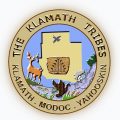
Klamath Tribes
The Klamath council represented the Klamath people and their 860,000 acres of land. The General Council was set up as a representative body. It included all the men of the tribe, and later included the women after the nineteenth amendment was enacted. The General Council met sporadically as issues concerning members arose.
- 501 Chiloquin Blvd.
Chiloquin, OR, 97624 - roberta.frost@klamathtribes.com
-
(541) 783-2219
- http://klamathtribes.org/
- https://www.facebook.com/KlamathTribes
-
Essential ServicesLegal Services
The Klamath council represented the Klamath people and their 860,000 acres of land. The General Council was set up as a representative body. It included all the men of the tribe, and later included the women after the nineteenth amendment was enacted. The General Council met sporadically as issues concerning members arose.
The Executive Council was created in 1908 at the request of the federal government because of the General Council’s sporadic meetings. The Executive Council was composed of twelve people. In 1929, after years of factional fighting among council members, the Executive Council was renamed the Business Council and a constitution and by-laws were created. The Tribal Loan Board and Enrollment Committee were branches of the Executive Council. Policy decisions made by the Executive Council had to have the approval of the General Council and the Bureau of Indian Affairs and the Department of the Interior.
The federal government used the branches of the tribal government to oversee the tribes. Much of the policy created by the tribal councils was for the benefit of the federal government and the policies were not widely followed by the Klamath people. The General Council was the branch of tribal government that most closely resembled traditional tribal government.
